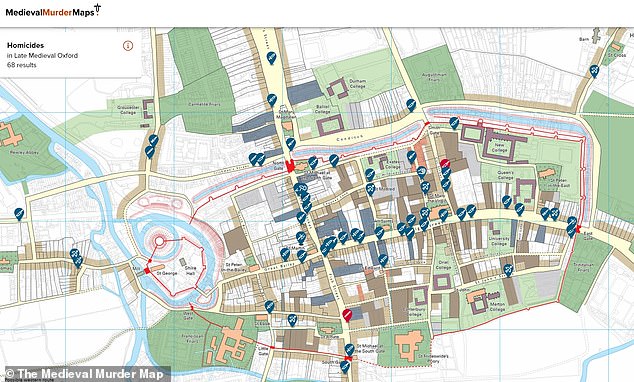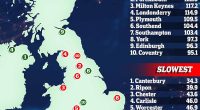
From Geoffrey Chaucer to Thomas Becket, several prominent figures were brutally murdered in medieval Britain.
Now, scientists have released an interactive map that shines a light on the 14th century bloodshed across London, Oxford and York.
In total, 354 homicides were recorded across all three cities, ranging from a deathly football match to a priest killing a man he found with his lover.
However, the researchers say that one city stands out above the rest.
They claim that Oxford should be named the ‘murder capital’ of medieval Britain – largely thanks to its student population.


Scientists have released an interactive map that shines a light on the 14th century bloodshed across London, Oxford (pictured) and York


From Geoffrey Chaucer to Thomas Becket, several prominent figures were brutally murdered in medieval Britain (stock image)
The Medieval Murder Map plots crime scenes based on investigations from 700-year-old coroners’ inquests.
Users can toggle between the three cities, and choose to filter the murders by genders involved, weapons used, the time and day of the incident, and the number of perpetrators.
Clicking on each icon will then bring up a case file about that murder, with some files also including audio versions of the inquests.
The researchers estimate that the homicide rate in Oxford was up to five times higher than late medieval London or York.
Among Oxford perpetrators with a known background, 75 per cent were identified by the coroner as ‘clericus’, as were 72 per cent of all Oxford’s homicide victims.
During this period, clericus is most likely to refer to a student or member of the early university.
‘A medieval university city such as Oxford had a deadly mix of conditions,’ said Professor Manuel Eisner, lead murder map investigator and Director of Cambridge’s Institute of Criminology.


The Medieval Murder Map plots crime scenes based on investigations from 700-year-old coroners’ inquests


Users can toggle between the three cities, and choose to filter the murders by genders involved, weapons used, the time and day of the incident, and the number of perpetrators
‘Oxford students were all male and typically aged between 14 and 21, the peak for violence and risk-taking.
‘These were young men freed from tight controls of family, parish or guild, and thrust into an environment full of weapons, with ample access to alehouses and sex workers.
‘As well as clashes between town and gown, many students belonged to regional fraternities called ‘nations’, an additional source of conflict within the student body.’
Based on their research, the team estimate the homicide rate in late medieval Oxford to work out around 60-75 per 100,000 – some 50 times higher than current rates in 21st century English cities.


Clicking on each icon will then bring up a case file about that murder, with some files also including audio versions of the inquests


The mix of young male students in Oxford and booze was often a powder keg for violence, the researchers say
The mix of young male students and booze was often a powder keg for violence.
A Thursday night in 1298 saw an argument between students in an Oxford High Street tavern result in a mass street brawl with swords and battle-axes.
The coroner recorded student John Burel had ‘a mortal wound on the crown of his head, six inches long and in depth reaching to the brain’.
In another incident, a gang of students killed one of their own, David de Trempedhwy, after he brought back a ‘harlot’ named Christiana of Worcester to their school in the winter of 1296.










